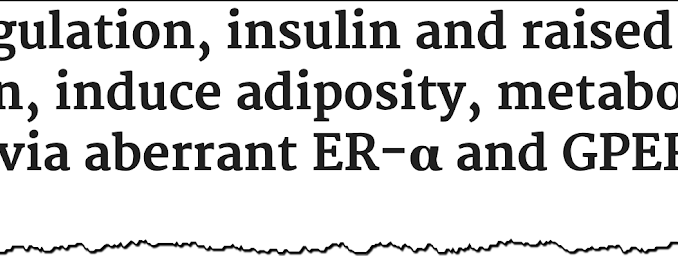
Men have high estrogen that is hurting their health — but this misleading blood test shows it in the normal range!
Unsubscribe | Report as spam | Change email preferences
Why high levels of estrogen don’t show up on a blood test
Most of the common diseases that affect men have been blamed on low testosterone levels.
Some of these problems include: obesity, man boobs, metabolic syndrome, type II diabetes, swollen prostate, and prostate cancer.
Clearly, having low testosterone is a problem in itself.
But in these men, high estrogen may be a more direct cause of these common diseases.
The problem centers around an enzyme called aromatase, the enzyme that turns testosterone into inflammatory estrogen.
But high levels of estrogen may not even show up on blood tests.
This happens when aromatase increases locally — for example inside the prostate.
So, many men can be suffering from diseases of high estrogen — where the root cause is very difficult to identify.
Most men need to take some simple steps to control aromatase — thereby controlling estrogen.
The review article was published in the Journal of Molecular and Cellular Endocrinology.
Low testosterone is clearly linked with many of the problems which afflict men today.
Experiments which replace testosterone in low-T-men have shown that low testosterone is clearly part of the problem — but low-T is only part of the problem.
“Reduced testosterone levels are related to obesity, insulin resistance, type II diabetes, heart disease, benign prostate hypertrophy and even prostate cancer – with little attention paid to the important role of increased intracellular estrogen in the pathogenesis of these chronic diseases.”
In other words, the role of a high estrogen is often overlooked.
This is partially a testing problem.
When we do hormone tests we usually look for hormone levels in the blood.
Here is where estrogen can get tricky — because the most powerful estrogen, estradiol, likes to hide out in the cells — evading blood tests.
Estradiol form of estrogen is made from testosterone — this process is done by an enzyme known as aromatase.
“Testosterone is metabolized to estrogen by aromatase.”
One important factor of this transformation is that aromatase can act differently in different parts of the body.
Cells in some parts of the body may have much more aromatase than elsewhere.
So, some of your cells may be loaded with estrogen — even though it doesn’t show up in blood tests.
“Testosterone is metabolized to estradiol in adipocytes, endothelial cells and prostate cells to increase intracellular estrogen at the expense of testosterone.”
Adipocytes are fat cells. Endothelial cells are cells which line blood vessels.
So fat cells, specific blood vessel cells and cells within the prostate all tend to generate extra estrogen that does not show up in blood tests.
These cells are heavily involved in many of the diseases we’re talking about here. Obesity, type II diabetes, cardiovascular disease and prostate problems.
These days we are exposed to many different foods and substances which can increase aromatase — triggering dangerous amounts of estrogen inside these cells.
“Stress, environmental estrogens, poor dietary choices and other toxins increase aromatase and intracellular estrogen.”
And we know that high estrogen can cause many of these health problems.
“Estrogen can cause insulin resistance, increased fat deposition, dyslipidemia and vasoconstriction.”
Vasoconstriction is the tightening of the blood vessels which can lead to high blood pressure.
“Activated estrogen receptors cause benign prostate hypertrophy and increased intracellular estrogen causes prostate cancer in mice.”
Our knowledge about the detrimental effects of intracellular estrogen is not limited to cell and animal experiments.
“Raised intracellular estrogen induces and promotes obesity, gynecomastia (man boobs), metabolic syndrome, type II diabetes, benign prostatic hypertrophy and prostate cancer.”
A part of the reason why some men have low testosterone is because their testosterone is getting converted into estrogen and increasing intracellular estrogen levels – leading to disease.
The authors of this review paper wanted to educate people on the risks of high intracellular estrogen — risks which are often misattributed to low testosterone.
“To understand that increased intracellular estrogen cause disease will reduce the rising incidence of obesity, metabolic syndrome and prostate disease worldwide.”
Much of the problems caused by high intracellular estrogen can be avoided by keeping aromatase low — using substances called “aromatase-inhibitors”.
You should always consult a healthcare practitioner about treating and diagnosing health-related problems.
—-Important Message—-
Most men have high estrogen — here’s how I fixed mine
A few years ago, on a lab result, my estrogen was through the roof.
And my doctor didn’t care — he said it happens to most men as they age.
So I started researching everything I could find about estrogen…
And it turns out, many men do have high estrogen once they turn 40 or 50…
And this leads to belly fat, low libido, chronic fatigue…
…and worst of all, terrible erections and performance problems for most men…
Thankfully, after a lot of trial and error, I’ve discovered a super simple way to lower my estrogen levels…
…at home, naturally, without the doctor…
And now I use it constantly!
Best of all, my wife LOVES the “new me” now that my estrogen is lower…
…because the difference in my body is SO VISIBLE when we make love…
…especially down there between my legs…I’m rockier and stiffer than ever…
Here’s what I’m doing to keep my estrogen levels low and my erections strong.
———-


